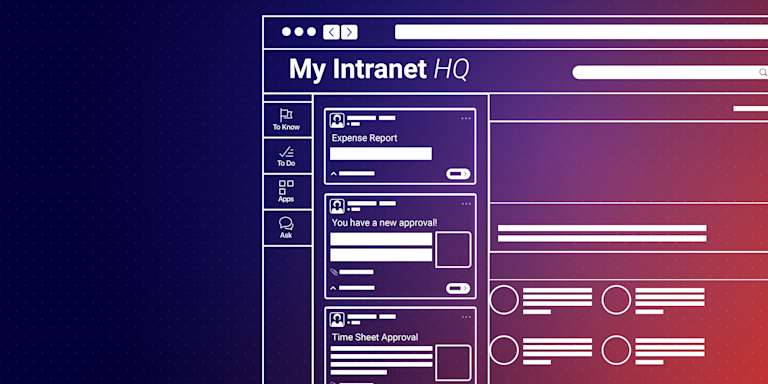The importance of intranet software
When planning for a new intranet, or even thinking about enhancing the intranet you already have, it’s easy to get caught up in the belief that having the right intranet software is where most of your time and energy should be spent.
But as the cornerstone of your digital workplace, your intranet fills a big role. It sets the tone for the mission, vision, and values of your organization and bears the weight of helping employees navigate the complexities of a likely hybrid work environment. Getting the intranet experience right requires a more comprehensive, strategic approach than just the selection of intranet software.
![[asset] Intranet Example with Workgrid Toolbar](https://images.ctfassets.net/z7p73u8c0thn/7wDR29oIfblfsPG2DoOEId/67ad02d6b47f417f45c9861c06dc2e45/Intra_Next_-Intranet_Names.png?w=1200&h=598&q=60&fm=png&bg=transparent)
Intranet software is only one of many considerations when creating a digital employee experience that’s ready for the future of work.
Optimizing the experience of your company intranet
Here are the top three considerations you should be thinking about if you want to ensure your intranet delivers the modern, intelligent experiences your workforce needs.
What is the most appropriate model for deployment?
What is the best intranet software?
Does the intranet offer the functionality employees need for a personalized, engaging experience?
Consideration 1: Most appropriate model for deployment
By now we’ve all accepted the fact that traditional intranets, the one-size-fits-all websites that only offer a single entry point, are about as relevant as portable CD players when it comes to digital workplace success.
Modern intranets, on the other hand, support the entire digital workplace experience. They are composable, supporting a variety of entry points for the consumption of digital workplace services. They also deliver functionality via a combination of channels, applications, and modalities.
![[asset] Microsoft Teams Integration](https://images.ctfassets.net/z7p73u8c0thn/WZmeYm8izeIPgpCc6jKhz/d115647bf443495898edc42f36911a92/MS_Teams_Updated_1221_3.png?w=1200&h=669&q=60&fm=png&bg=transparent)
A modern intranet such as this is exactly the kind of experience you should aim for. As described in their report, Modern Intranet Top Practices, Gartner's intranet front door-side door model is a good framework for delivering the services of your intranet via the right combination of channels, applications and modalities.
According to Gartner, “The intranet front door is frequently a destination site, either centralized, decentralized or delivered via an employee portal. The side doors include a variety of other entry points, including mobile, search-based, conversation-based and others. In addition to the front door, application and software engineering leaders should identify which side doors are important for their employees to use and provision them.”
Entry points to consider for your intranet deployment can include destination sites, employee portals, mobile devices, business applications, collaboration sites, search mechanisms, virtual assistances, and activity hubs.
Consideration 2: Intranet Software
Just because intranet software isn’t the only consideration when it comes to building a modern intranet doesn’t mean you shouldn't give it careful thought. It probably requires extra thought, actually, because you can’t shortcut the decision of which platform to choose. There’s no such thing as the “best” intranet platform overall – just the one that best meets your needs, so you should think carefully about your requirements and strategy for your intranet.
![[asset] Crossroads Blog Image 600x350](https://images.ctfassets.net/z7p73u8c0thn/1bW6iT6sUP8nOIrCve3Hgd/8f42f2c4852dec3a13a05524a706ece5/Crossroads_Blog_Image_600x350.png?w=600&h=350&q=60&fm=png&bg=transparent)
There are multiple options to choose from when it comes to selecting intranet software; pre-packaged solutions or the platform approach that leverages SharePoint or a Web Content Management (WCM).
It’s important to consider this point carefully because there are two different routes you can choose. You can either opt for a packaged solution, sometimes referred to as “intranet in a box,” or you can choose to take a platform approach that leverages SharePoint or a Web Content Management (WCM) such as Drupal or Sitecore. The path you choose is entirely dependent on what your organization needs. Goals, timelines, and budgets should be taken into consideration. And once you’re clear on what your needs are, there are some good reports and comparison sites that can help you understand the pros and cons of all the main vendors.
Despite being only one of many considerations you’ll make regarding your intranet, don’t discount the fact that your choice of intranet software will serve as the foundation for the experience you deliver. So make sure the platform you select is flexible, cost-effective, and supported by a team that is invested in the long-term success of your intranet.
Consideration 3: Does it offer the functionality employees need for a personalized, engaging experience?
It’s unrealistic to expect that any intranet software platform will be able to meet all the unique needs of your business and workforce. Don't be fooled by so-called integrations. Sometimes they're not what you think they are.
![[asset] Intranet Levels](https://images.ctfassets.net/z7p73u8c0thn/3ZQCoQ0oj7vPe7jbaVZYtV/6f89bfaa70ea6c13a66ee1f21db2329d/Intranet_Levels.jpg?w=1200&h=750&fl=progressive&q=60&fm=jpg&bg=transparent)
There are four levels of integration use on the intranet. Only level four delivers the modern experience employees need.
Enabling integrations on your intranet can be a tricky business and there are lots of areas where they can go wrong. But despite these inherent difficulties, many intranet software vendors still claim to be able to offer integrations. What they really mean, though, is that they can provide links to enterprise systems, which is not the same thing.
Your intranet stands a better chance of long-term success if you don’t put all your eggs in the basket of whichever intranet software platform you choose. Plan on implementing additional tools and services to enhance the intranet experience and find a platform that meets your specific needs.
Here are two modern intranet features you should consider
Eliminate the friction that can have a negative impact on the employees experience with these modern intranet enhancements:
Integrations with enterprise systems
As mentioned above, integrations are not links. While links just provide access to applications from the intranet, integrations actually extract the key aspects different systems and applications, weaving the functionality into custom experiences for employees. They help employees complete required tasks that span multiple applications from a single, seamless experience, integrating important tasks and information into the flow of work and eliminating the mental load of context switching.
![[gif] service-now-approval-procurement](http://images.ctfassets.net/z7p73u8c0thn/6pRC5pu6L27Elnr2WSpBWH/cb83ce56e4c20935e2b704de064ba6a3/asses-service-now-approval.gif)
Offering integrations on your intranet is critical to providing the modern, intelligent experiences employees need. Integrations that make it easier to interact with enterprise systems will drive significant engagement and increase productivity - but be forewarned that getting integrations right is no easy task. Building them yourself is technically an option, but the reality is that the DIY approach isn’t ideal. It’s time consuming and can be a drain on internal resources to even attempt.
Thankfully there are a variety of options for outsourcing the implementation of integrations on your intranet, one of which is through a digital experience layer.
Digital experience layers separate the user experience (UX) from underlying source systems, giving organizations the flexibility to control and design experiences that meet employees’ needs by helping them fulfill their intent (i.e. accomplishing routine tasks with fewer clicks) - all while maintaining investments in the best-of-breed business applications that keep business running.
Here is an example of what integrations can look like using an AI Assistant for work like Workgrid.
Workgrid abstracts important tasks, notifications, and information from key HR, IT, and finance systems, presenting it to employees in a centralized location that’s accessible wherever they are, whether in front of a computer or on the go.
Conversational AI Assistants
The prevalence of chatbots in the workplace (beyond their use in customer service, that is) has grown significantly in recent years. In fact, 64% of employees have recently claimed in surveys that they would trust an AI chatbot more than their manager, with half of them turning to a chatbot for advice rather than their manager. The majority of employees – 65% - are also optimistic, excited, and grateful about having chatbots as coworkers.
This acceptance and enthusiasm is understandable. Natural language chatbots have a lot to offer when it comes to delivering a modern experience.
![[asset] conversational-ai-at-work-1920x1080](https://images.ctfassets.net/z7p73u8c0thn/4VC9HpyA56j1npPmFuJmr9/306f149950f9b9cd9b32980404070434/conversational-ai-at-work-1920x1080.jpg?w=1200&h=675&fl=progressive&q=60&fm=jpg&bg=transparent)
To start, they’re available 24/7 to answer routine questions, which frees up significant time for HR and other departments to focus on more strategic initiatives. They can also facilitate self-service functionality, such as submitting help desk tickets (think unlocking mobile devices and resetting passwords), and they streamline common processes such as onboarding, employee reskilling/upskilling, and more.
With all of that to offer, providing a chatbot on your intranet should be a no-brainer. Here’s an example of the utility Workgrid’s AI Assistant adds to the intranet experience.
![[gif] service-now-catalog-mouse-order](http://downloads.ctfassets.net/z7p73u8c0thn/4uP2KihBMtwKKvHgxBHib9/51c758c6d57243dca19d43874d742667/gif-servicenow-catalog-735x650.gif)
Delivering a modern intranet experience
Achieving digital workplace success relies on your ability to deliver a modern, intelligent intranet experience. Choosing the right intranet software is an important part of this process, but so is understanding the needs of employees to enhance the intranet with the features and functionality that improve productivity, increase engagement, and ensure long-term happiness and satisfaction.
To see an example of what an enhanced intranet experience can look like for your organization, check out this quick video:




